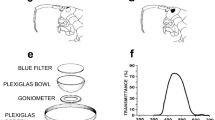Summary
-
1.
Certain features of the optical geometry of theNotonecta dioptric apparatus were studied. The cornea consists of two homogeneous layers; in the distal layer the refractive index is high, and in the proximal layer it is low. The two are separated by a bell-shaped transition region. This aspherical zone has almost exactly the shape one would anticipate in a system corrected for spherical aberration (Fig. 10). The outer surfaces of the individual corneal lenses are only slightly convex; therefore there is little change in the position of the plane of focus in the eye when the animal leaves the water.
-
2.
The ommatidia, perpendicular to the corneal surface in the central region, lie at progressively greater angles at positions further medial and lateral (Fig. 3); for this reason the whole compound eye has a broad visual field (Fig. 11) despite its slight curvature.
-
3.
75% of the optical axes of all the ommatidia are in the binocular visual space.
-
4.
Observation of the displacement of the pseudopupil during rotation of the animal about a transverse axis reveals two zones of high acuity (Fig. 5). An animal resting below the water surface looks horizontally through the water with one of these zones. The other high-acuity zone is very small and lies 43 °±3 ° further ventral, so that it aims at the water surface just beyond the edge of the totally reflecting zone. With these ommatidia the animal can see the space just above the water surface.
-
5.
In the ventral part of the eye the lattice of the optical axes is arranged in such a way that the vertical extent of a small object is always imaged in the same number of ommatidia regardless of distance, when the object is in the range 4.5 to 1.5 cm and 1 to 0 cm in front of the animal in the plane of the water surface. The range 1.5 to 1 cm is viewed by the high-acuity zone with which the animal scans the surface.
-
6.
The extent to which the properties of movement-sensitive interneurons (Schwind, 1978) are based on the measured gradients in the optical lattice is discussed.
Similar content being viewed by others
References
Bedau, K.: Das Facettenauge der Wasserwanzen. Z. Wiss. Zool.97, 417–456 (1911)
Beersma, D.G.M., Stavenga, D.G., Kuiper, J.W.: Organization and visual axes of compound eye of the flyMusca domestica L. and behavioural consequences. J. Comp. Physiol.102, 305–320 (1975)
Beersma, D.G.M., Stavenga, D.G., Kuiper, J.W.: Retinal lattice, visual field and binocularities in flies. J. Comp. Physiol.119, 207–220 (1977)
Born, M., Wolf, E.: Principles of Optics. 3. edn. London, New York: Pergamon Press 1965
Burkhardt, D., Darnhofer-Demar, B., Fischer, K.: Zum binokularen Entfernungssehen der Insekten. I. Die Struktur des Sehraumes von Synsekten. J. Comp. Physiol.87, 165–188 (1973)
Burkhardt, D., Motte, I. de la, Seitz, G.: Physiological optics of the compound eye of the blowfly. In: The functional organization of the compound eye. Bernhard C.G. (ed.), pp. 51–62. Oxford: Pergamon Press 1966
Clarkson, E.N.K., Levi-Setti, R.: Trilobite eyes and the optics of DesCartes and Huygens. Nature254, 663–667 (1975)
Del Portillo, J.: Beziehungen zwischen den Öffnungswinkeln der Ommatidien, Krümmung und Gestalt der Insektenaugen und ihrer funktionellen Aufgabe. Z. Vergl. Physiol.23, 100–145 (1936)
Exner, S.: Die Physiologie der facettirten Augen von Krebsen und Insecten. Leipzig, Wien: Deuticke 1891
Frantsevich, L., Pichka, V.E.: Dimensions of the binocular zone of the visual field of insects (in Russian). Zh. Evol. Biokhim. Fiziol.12, 461–465 (1976)
Friedrichs, H.F.: Beiträge zur Morphologie und Physiologie der Sehorgane der Cicindeliden (Col.) Z. Morphol. Ökol. Tiere21, 1–172 (1931)
Grenacher, H.: Untersuchungen über das Sehorgan der Arthropoden, insbesondere der Spinnen, Insekten und Crustaceen. Göttingen: Vandenhoeck und Ruprecht 1879
Horridge, G.A.: The separation of visual axes in apposition compound eyes. Philos. Trans. R. Soc. (London), Biol.285, 1–59 (1978)
Ioannides, A.C., Horridge, G.A.: The organization of visual fields in the hemipteran acone eye. Proc. R. Soc. (London), Biol.190, 373–391 (1975)
Kirschfeld, K., Reichardt, W.: Die Verarbeitung stationärer optischer Nachrichten im Komplexauge vonLimulus (Ommatidien-Sehfeld und räumliche Verteilung der Inhibition). Kybernetik2, 43–61 (1964)
Lüdtke, H.: Die Funktion waagrecht liegender Augenteile des Rückenschwimmers und ihr ganzheitliches Verhalten nach Teil-lackierung. Z. Vergl. Physiol.22, 67–118 (1935)
Lüdtke, H.: Retinomotorik und Adaptationsvorgänge im Auge des Rückenschwimmers (Notonecta glauca L.). Z. Vergl. Physiol.35, 129–152 (1953)
Meyer, H.W.: Differenzierte Orientierungsleistung und räumliche Organisation des Insektenauges. Fortschr. Zool.21, 294–306 (1972/73)
Schwind, R.: Visual system ofNotonecta glauca: A neuron sensitive to movement in the binocular visual field. J. Comp. Physiol.123, 315–328 (1978)
Scitz, G.: Der Strahlengang im Appositionsauge vonCalliphora erythrocephala (Meig.). Z. Vergl. Physiol.59, 205–231 (1968)
Snyder, A.W.: Acuity of compound eyes: Physical limitations and design. J. Comp. Physiol.116, 161–207 (1977)
Stavenga, D.G.: Pseudopupils of compound eyes. In: Handbook of Sensory Physiology, Vol. VII/6A. Comparative physiology and evolution of vision in invertebrates. Autrum, H. (ed.), pp. 357–440. Berlin, Heidelberg, New York: Springer 1979
Vogt, K.: Optische Untersuchungen an der Cornea der MehlmotteEphestia kühniella. J. Comp. Physiol.88, 201–216 (1974)
Wohlburg-Buchholz, K.: The organization of the lamina ganglionaris of the hemipteran insects,Notonecta glauca, Corixa punctata andGerris lacustris. Cell Tissue Res.197, 39–59 (1979)
Zänkert, A.: Vergleichend-morphologische und physiologisch-funktionelle Untersuchungen an Augen beutefangender Insekten. Sitzungsber. Ges. Naturforsch. Freunde Berlin1–3, 82–169 (1939)
Author information
Authors and Affiliations
Additional information
I thank the Deutsche Forschungsgemeinschaft for financial support, Prof. Burkhardt and Dr. de la Motte for critically reading the manuscript and for helpful discussions, Dr. Streng for writing the program for the calculation ofF 2 in Fig. 10, Prof. Kirschfeld and Dr. Vogt for a discussion, Mrs Biederman-Thorson Ph. D. for translating the major part of the text, Dr. Loftus for the help to translate paragraphs 2 to 4 of the Discussion and Miss Humbs for technical assistance.
Rights and permissions
About this article
Cite this article
Schwind, R. Geometrical optics of theNotonecta eye: Adaptations to optical environment and way of life. J. Comp. Physiol. 140, 59–68 (1980). https://doi.org/10.1007/BF00613748
Accepted:
Issue Date:
DOI: https://doi.org/10.1007/BF00613748




